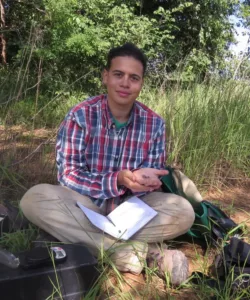 Gabriel Jamie became interested in science as a child through watching birds, first in Cape Town and then in the United Kingdom. This has resulted in a life-long avian obsession that has led him to fieldwork on birds in many places around the world. As a teenager he worked on projects studying migratory birds in the Danube Delta of Romania and on Antikythira in Greece. While doing an undergraduate degree in Natural Sciences at the University of Cambridge, Gabriel spent summers working as a research assistant studying bird communities in Peru with scientists from Oxford University and Conservation International. After graduating, Gabriel went on to do a PhD with Prof. Claire Spottiswoode at University of Cambridge conducting fieldwork in Zambia to study mimicry and speciation in the brood-parasitic Vidua finches (indigobirds and whydahs). Gabriel is currently a Leverhulme Research Fellow at the University of Cambridge where he continues to study brood-parasitic birds in Africa. Gabriel’s current work focuses on the interactions between the brood-parasitic Cuckoo Finch (Anomalospiza imberbis) and its Tawny-flanked Prinia (Prinia subflava) hosts. Prinias have evolved incredibly diverse eggs which vary dramatically in colour and pattern between individuals. Gabriel is currently investigating the genetic basis of this diversity and the consequences of this genetic architecture for the co-evolutionary trajectories in the ongoing arms race between prinias and their Cuckoo Finch parasites. Gabriel is involved in ornithological expeditionary work and the conservation of African birds and is a Research Associate at the FitzPatrick Institute of African Ornithology at the University of Cape Town. In November 2016, Gabriel was part of an expedition to the Njesi Plateau in northern Mozambique with researchers from BINCO. Together with Sam Jones, they discovered new populations of the highly endangered Mozambican Tailorbird (Artisornis sousae) and Dapplethroat (Modulatrix orostruthus) as well as finding two species previously unrecorded from Mozambique.
Gabriel Jamie became interested in science as a child through watching birds, first in Cape Town and then in the United Kingdom. This has resulted in a life-long avian obsession that has led him to fieldwork on birds in many places around the world. As a teenager he worked on projects studying migratory birds in the Danube Delta of Romania and on Antikythira in Greece. While doing an undergraduate degree in Natural Sciences at the University of Cambridge, Gabriel spent summers working as a research assistant studying bird communities in Peru with scientists from Oxford University and Conservation International. After graduating, Gabriel went on to do a PhD with Prof. Claire Spottiswoode at University of Cambridge conducting fieldwork in Zambia to study mimicry and speciation in the brood-parasitic Vidua finches (indigobirds and whydahs). Gabriel is currently a Leverhulme Research Fellow at the University of Cambridge where he continues to study brood-parasitic birds in Africa. Gabriel’s current work focuses on the interactions between the brood-parasitic Cuckoo Finch (Anomalospiza imberbis) and its Tawny-flanked Prinia (Prinia subflava) hosts. Prinias have evolved incredibly diverse eggs which vary dramatically in colour and pattern between individuals. Gabriel is currently investigating the genetic basis of this diversity and the consequences of this genetic architecture for the co-evolutionary trajectories in the ongoing arms race between prinias and their Cuckoo Finch parasites. Gabriel is involved in ornithological expeditionary work and the conservation of African birds and is a Research Associate at the FitzPatrick Institute of African Ornithology at the University of Cape Town. In November 2016, Gabriel was part of an expedition to the Njesi Plateau in northern Mozambique with researchers from BINCO. Together with Sam Jones, they discovered new populations of the highly endangered Mozambican Tailorbird (Artisornis sousae) and Dapplethroat (Modulatrix orostruthus) as well as finding two species previously unrecorded from Mozambique.
- Current Events
- Upcoming Events
- Past Events
